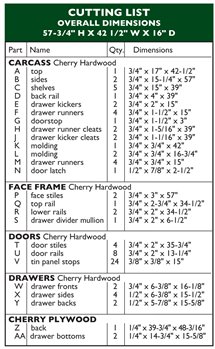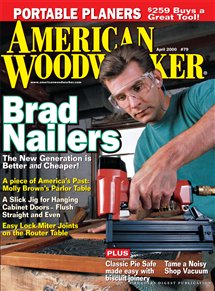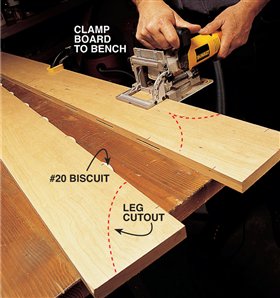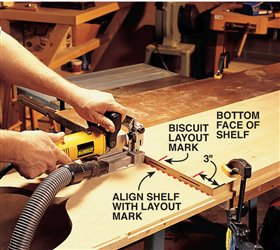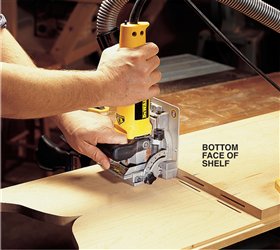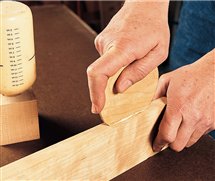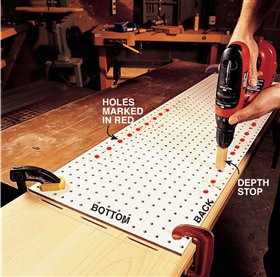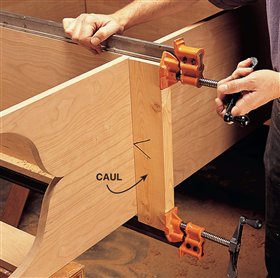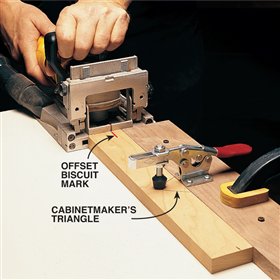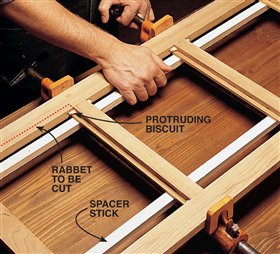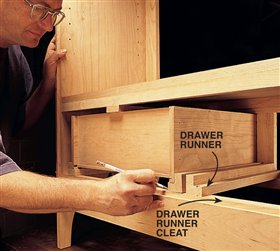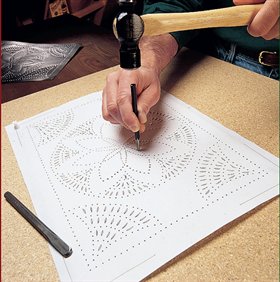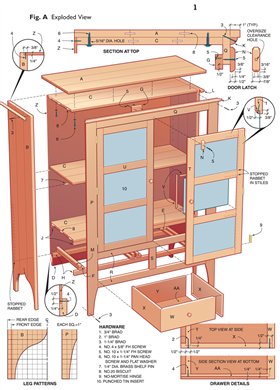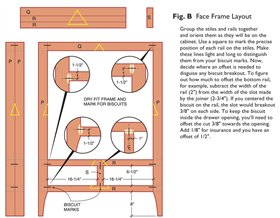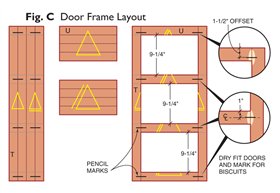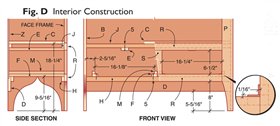Pie safes like this one were once
commonplace. The pierced-tin panels
kept insects out while providing ventilation
for cooling baked goods.
Our version is built of solid cherry with
a simple, modified-Shaker style that blends
easily into most any decor. Adjustable shelves
and a pair of drawers make it a versatile storage
cabinet. The pierced-tin panels that once
cooled pies provide ventilation for a modern
sound system. Or, you can use this pie safe to
store clothing and take some of the pressure
off that overstuffed closet or bureau.
Biscuits make the joinery on this project
as easy as pie. If you’ve never made a project
of this scale before, or are new to biscuit
joinery, this is the perfect place to start. You’ll
need to know how to make stopped rabbets
for the back and dadoes for the drawers, but
hanging the flush-fit doors is a breeze with
no-mortise hinges.
Getting off to a good start
You’ll need a biscuit joiner, a tablesaw set, a
router with a 3/8″ rabbeting bit and a jigsaw
to complete this project. With the exception
of the drawer bottoms and back, the
whole cabinet is made of solid cherry. One
of the tricks to using cherry is to be fussy
about your lumber. The color of cherry can
vary greatly (that’s why it’s often stained
dark by manufacturers). Select boards with
uniform color or ask that the wood you
order come from a single tree.
We spent about $900 on this pie safe.
You can shave off some of that cost by
punching your own tin. Now, let’s head for the shop.
Start with the wood
Sort your wood for grain and color. Most
cherry boards have some sapwood, the offwhite
wood found on the outer edge of the trunk. Plan your cuts so the sapwood is
kept to the inside where it won’t show.
Select flat, straight-grained wood for the
doors and face frame. This is one place
you can’t afford any warping. Cut the
drawer fronts (W) from a single board
so the grain flows from one drawer to
the next. Choose boards with compatible
figure and color for the sides (B)
and top (A). Use the less desirable pieces
for shelving.
Tips for better
biscuiting
-There are three common sizes of
biscuits: #20, #10 and #0. #20 biscuits
offer the greatest gluing surface and
are therefore the strongest. Use these
whenever possible even if it results in
the biscuit “breaking out” of the joint
(Photo 8). Breakout occurs on the face
frame and door frame where narrow
rails join the stile. But that’s not a problem
if you offset the center mark for the
biscuits so the breakout won’t be seen.
We did this on the face frame so the
biscuits break out where the drawers
and top cover them (Fig. B). Breakouts on the door frames are covered by the
tin panel stops. We offset the top-rail
biscuits to keep the top edge of the
door clean (Fig. C).
-Assembly with biscuits needs to
go smoothly because the biscuits
swell quickly once glue is applied.
For a more relaxed assembly, use an
extended-open-time glue like Titebond’s
Type II Extended or Liquid
Hide Glue (see Sources, below).
-Take the time to dry-fit each assembly
using all the biscuits and clamps
you’ll need for the real thing. You’ll be
able to rehearse your glue up and red
flag any misaligned biscuits.
-Getting glue in the biscuit slots can
be a bit messy. Just squirt a bead into the groove and spread it along both
side walls of the slot with a small glue
brush (see Sources, below).
The carcass
1. Lay out and cut the biscuit slots for
the top (A), sides (B) and shelves (C)
(Photo 1).
2. Dry-fit first then glue up and cut
to length.
3. Use the leg patterns (Fig. A) to lay
out the shapes on the bottoms of the
sides. Cut them out with a jigsaw.
4. Use a tablesaw to cut the rabbet
on the back rail (D) for the back (Z).
Use a router with a 3/8″ rabbeting bit
to cut the stop rabbet on the sides for
the back.
5. Lay out the fixed shelf locations on
the cabinet sides, then cut the biscuit
slots for the shelves and the back rail
(Photos 2 and 3).
6. Drill holes for adjustable shelf pins
(see Sources, below; Photo 4).
7. Finish-sand all the pieces starting
with 120-grit and working your way
to 320-grit for an oil finish. If you plan
to varnish, stop at 220-grit.
8. Dry-fit and glue the carcass using
four clamps and cauls for the shelves
(Photo 5) and a fifth clamp for the
back rail. Be sure the carcass is glued
up square.
9. Glue the drawer kicker cleats (J) to
the bottom of the lower shelf. If you
own a pneumatic brad nailer, tack the cleat in place first so it won’t slide
around when you apply the clamps.
(Brad nailers can be like a third hand
during assembly.)
The face frame
10. Lay out the face frame, as shown
in Fig. B.
11. Cut the biscuit slots (Photo 7)
and dry fit the face frame.
12. If you are mortising in your
hinges, now’s the time to lay out and
cut the hinge mortises on the inside
edges of the face stiles.
13. Lay out and cut the leg profiles
on the bottom of each stile (Fig. A).
14. Begin the glue up with the
drawer divider mullion (S) and the
lower rails (R). Then glue the rest of
the face frame together.
15. Trim the protruding biscuits and
finish sand.
Final assembly
16. Glue the face frame assembly to
the carcass. Tack the face frame in
position with brads before applying
clamps. Trim the face frame overhang
with a flush-trim bit in a router.
17. Center the drawer kickers (E)
in the drawer openings and attach
them to the kicker cleats with a 6 x
1-1/2″ screw.
18. Attach the drawer runner cleats
(H, Fig. D) with a brad, glue and
clamps.
19. Assemble the drawer runners
(F and M) and position them on
the cleats so they set 1/16″ into the
drawer openings (Fig. D). Attach
the runners to the front cleat only
(Fig. D). You’ll attach the back of
the runners later.
20. Attach the top (Fig. A).
21. Make the cherry quarter-round
molding (K and L) from a 3″ wide
piece of cherry. Round over the two
long edges with a router and a 3/4″
round-over bit. Rip the moldings off
the piece and cut to fit. Glue and nail
the front molding in place. Nail the
side moldings in place but only glue
the miter joint and the first couple of
inches at the front of the case. This will
keep the miter joint tight but still allow
the carcass to move with the seasons.
The doors
22. Use a tablesaw to cut the rabbets
on the back edges of the door rails (U).
23. Cut biscuit slots, dry-fit, glue and
clamp the door frames (Photo 8).
24. Finish the rabbets on the doors
with a router and a 3/8″ rabbeting
bit—this will also trim the protruding
biscuits. Square the corners with
a sharp chisel.
25. Fit the doors.
26. Make the door latch (N) and
mount it and the door stop (G, Fig. A.)
27. Make the tin panel stops (V) and
miter to fit in place, but don’t attach
them yet.
The drawers
28. Cut the dadoes and rabbets in the
drawer fronts (W) and sides (X).
29. Finish-sand the insides of the
drawer pieces, then glue and nail the
drawers together making sure they
are square.
30. Finish-sand the outside of the
drawers.
31. Attach the drawer runners to the
drawer runner cleat (Photo 9).
32. Drill holes for the door and
drawer knobs.
33. Attach the back with screws.
Screws allow you to easily remove
the back for finishing and you won’t
be accidentally driving nails through
the side of the cabinet.
The finish
34. Finish-sand the outside surfaces
and ease the edges.
35. Apply three coats of Danish oil.
36. Mount the tin panels in the
doors, hang the doors and attach
the knobs.
37. Attach the back and stand back
to admire your work.
Just think; food safes like this used
to hold biscuits; now they’re held
together by them!
Sources
Frank Paxton Lumber Company, paxtonwood.com, 800-522-3305, 4/4 Cherry, 100 bd. ft.;
1/4″ x 4′ x 8′ cherry plywood.
Titebond, titebond.com,
Titebond II Extended, 1 gal., $29.99;
Titebond Liquid Hide Glue, 16 oz.,
$13.99.
Highland Woodworking, highlandwoodworking.com, 800-241-6748, Small glue brush
(pack of 10), #166025, $2.50; 2-3/4″
Horizontal toggle clamp, #166105,
$11.99 ea.
Woodcraft, woodcraft.com, 800-225-1153, 1/4″ dia. brass
shelf supports (25), #27I11, $2.99;
Pewter no-mortise ball hinge,
#130191, $4.50 each.
Van ***’s, vandykes.com, 800-558-1234, 1-1/4″ dia. cherry
knob, #02032579, $1.79 ea.
Country Accents, piercedtin.com, 570-478-4127, Pierced-tin
panel, 10″ x 14″, $20 – $30 each, depending on the pattern.
Cutting List

This story originally appeared in American Woodworker April 2000, issue #79.

April 2000, issue #79
Purchase this back issue. |
|
Click on any of the images to view a larger version

1. Cut the biscuit
slots about 6″ apart for
edge joining. The biscuits
align the surface of the
boards producing flush
joints that require little
sanding. You don’t want
to expose a biscuit
joint when making your
final cuts so keep your
biscuits at least 3″ away
from the ends of the
top (A) and the leg
cutout area on the
sides (B).

2. Cut the slots in
the end of the shelf
with the base of the
plate joiner on the
cabinet side. Clamp
the shelf on the side
so the top edge of the
shelf lines up with the
top edge of the layout
mark on the side.
Mark for biscuits in the
middle of the shelf and
3″ in from each end.

3. Cut the slots in the side with the plate joiner held
vertical and using the markings on the shelf.
Oops!

Somehow we managed to cut a biscuit where none belonged. A careless pencil mark can be mistaken for a biscuit mark when you’re cutting your way through a pile of frame members. Here’s how we fixed it: Use a compass to mark a 4″ dia. circle in some 5/32″ thick cherry and cut it out on the bandsaw. Glue the circle into the bad slot and clean up any excess glue. After the glue dries, flush-cut the repair.

4. Drill for adjustable shelf pins using a perfboard
template. Mark the bottom and back edge to
correctly register the template on the other side of
the cabinet. Mark the holes to be drilled (every other
hole gives a 2″ spacing) and use a sharp brad-point
bit. Make your own fool-proof depth stop from 3/4″
x 3/4″ stock that’s drilled down the center and cut to
length.

5. Clamp the carcass assembly using shop-made
cauls to distribute clamping pressure across a wide
joint. See Photo 6 for
how to make cauls.

6. Make your cauls from 2x4s cut to the width of the cabinet. Make sure they are
well dried and all four sides are square. Plane or sand a 1/16″ crown on each caul and mark
the crown with an arrow. While you’re at it, make some extras and keep them for future use.

7. Cut slots in the ends of narrow parts, like this
face frame rail, using a simple jig to steady the work
and provide a wider surface for the plate joiner
fence. We used a 12″ x 30″ piece of melamine with a
3″ x 18″ piece of hardwood centered along the edge.
Add a couple of hold-down clamps (see Sources, below left). Note how the cabinetmaker’s triangle identifies
the piece being cut as the top rail.
The Cabinetmaker’s Triangle
Labeling your project parts with letters and numbers works fine when you’re dealing with a few pieces. But if your pile of parts gets mixed up it can take a while to sort things out again. The cabinetmaker’s triangle allows you to instantly identify the location and orientation of each individual piece. Here’s how it works: Group your frame members face-side up in the same orientation they will have when assembled (stiles are vertical, rails are horizontal, etc.). Mark each group with a triangle that points up towards the top of the cabinet. (With parts like the top and shelves, the triangle will point to the back of the cabinet). The triangle leaves two lines on each piece making identification a snap (See Figs. B and C, below). If two or more assemblies are identical, like our pair of doors, add an extra line along the triangle’s side for the rails and along the bottom for the stiles.

8. Assemble your door
frames on a perfectly flat
surface using identical clamps.
This helps ensure a flat door
and saves all kinds of headaches
later. Spacer sticks hold the
frame up off the clamps (so it
won’t get stained) and in line
with the clamp screw pressure
(so it won’t get twisted). Note
how the biscuits protrude
into the panel rabbets. They’ll
be removed later when the
rabbets are completed with a
router.

9. Mark the position of the
drawer runners on the
lower back support cleat. Have
the drawer in place with even
margins around the opening
and enough room between
the slides and drawer sides for
smooth operation. Remove the
drawer and fasten the runners
with screws.
Punch Your Own Tin!

You’ll save money and have fun
doing it. Everything you need is
available at Country Accents (see
Sources, at left):
10″ x 14″ tin blanks ($4.30
each); the pattern ($2); the hole
punch (T-0359, $5.95); and the
lampmaker’s chisel (T-0259-3/8,
$7.95). Expect to spend 30 to 40
minutes punching each panel. Don’t
try to do all six in a row or you’ll
feel like punching more than
tin. Take it easy and
spread the job over
a few days.
Wear a pair of
gloves when handling
the tin to keep from etching
in fingerprints. Tape the pattern
to the tin with masking tape. Use
pushpins to hold the work down
on a piece of particleboard and
have at it. Complete instructions
come with every order.
Fig. A: Exploded View

Fig. B: Face Frame Layout

Fig. C: Door Frame Layout

Fig. D: Interior Construction

|




